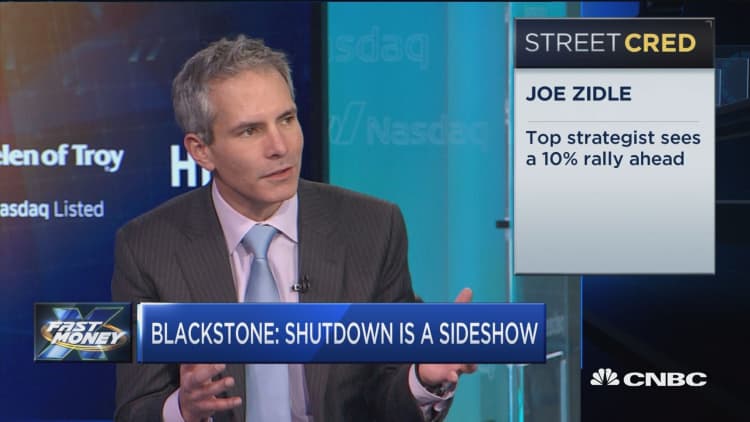
The can rally about 15 percent this year despite the ongoing government shutdown sideshow that's now in its third week, according to Blackstone's new chief investment strategist, Joseph Zidle.
Zidle told CNBC's "Fast Money" Tuesday evening that he does not expect the nearly month-long budget standoff to derail the market from rebounding this year. He sees the S&P 500 climbing to 2,875 by the end of this year.
The index closed out 2018 with a 6.2 percent decline after the final three months of last year sent Wall Street into a bear market — measured by a decline of 20 percent or more from recent highs. The Dow Jones Industrial Average, S&P 500, and Nasdaq are off to solid gains in 2019. However, they were all still in correction territory after Tuesday's strong gains. A correction is defined as a decline of 10 percent or more from recent highs.
As for the partial shutdown, now the longest in American history, it has furloughed 800,000 federal workers and left four million federal contractors without pay. Those federal workers have been promised that they'll receive backpay, but contractors will be out of luck.
"I don't see any real lasting effect here because people are going to get paid and they're going to be made whole," said Zidle. After a roughly yearlong transition, he officially succeeded renowned strategist Byron Wien, 86, who holds the title of vice chairman of private wealth solutions at Blackstone.
A White House official said the shutdown could reduce growth by 0.1 percent each week that it continues, but Zidle called this the worse case scenario "assuming the shutdown does not end." He played down worries that it could put a significant dent in the economy because workers have options to stay afloat in the meantime, such as filing for unemployment.
Once Democrats and Republicans can agree on a plan to end the funding gap "people are going to be made whole on their paychecks," Zidle said. "So, if we do see a drop to first quarter growth or if we see some sort of hit to corporate profits, I think [in] the second quarter we're going to see all that coming back and more."
The veteran portfolio strategist, whose resume includes a stint at Richard Bernstein Advisors, called the effects of the shutdown a "completely different issue" than the ongoing trade war between the United States and China. That, he pointed out, could derail an increase in equities.
"I think we need to get that wrapped up in order to have any type of meaningful rally in the stock market," Zidle said.
The self-proclaimed "stubborn bull," whose Santa Claus rally projection never materialized at the end of 2018, predicts that the trade dispute would be resolved in the first or second quarter of this year. He argued the markets overreacted in 2018 and that this is an opportunity to buy.
"If there's a silver lining to the policy uncertainty is it probably keeps central banks more dovish," Zidle said.


